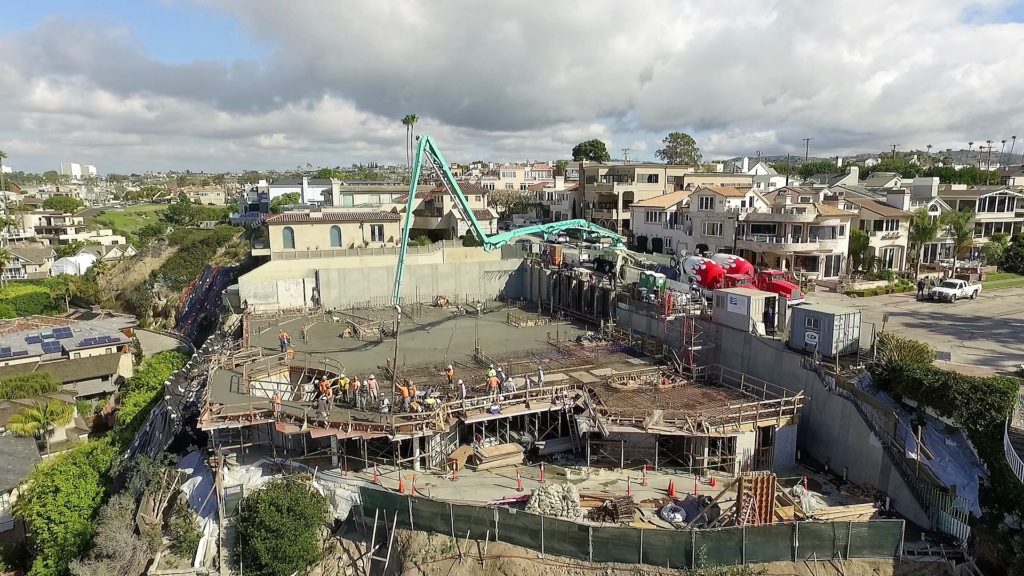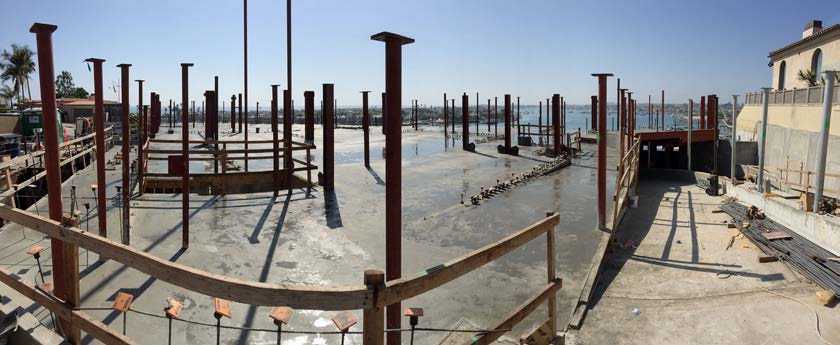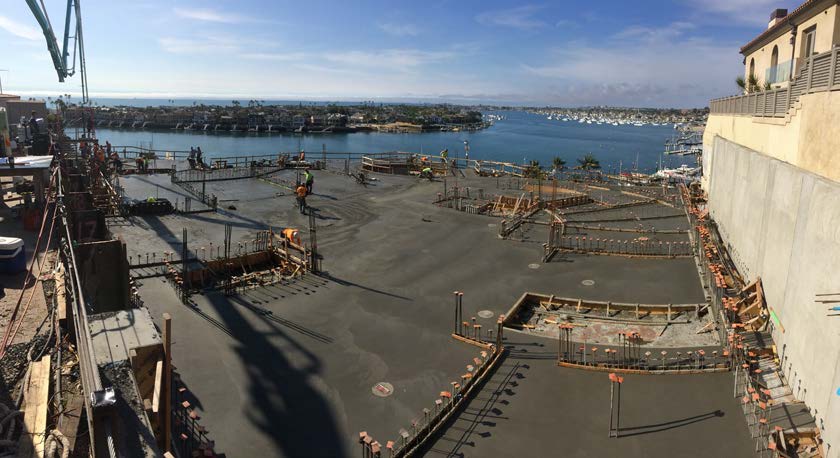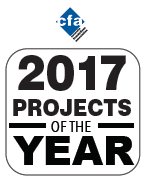2017 Projects of the Year Overall Grand Project: Going Out On A Limb Is Easier Than Building On A Cliff…
The 2017 Projects of the Year Awards… continued excellence in the field of cast-in-place concrete.
OVERALL GRAND PROJECT OF THE YEAR
Single Family Residence Over 5,000 sq.ft.
Aerie Residence by Ekedal Concrete, Inc.,
Newport Beach, California
Corona Del Mar, California
15,000 sq.ft. Single Family Residence
Canadian novelist David Bergen once quipped, “I think a construction project for me is like writing a novel. I can’t do the project unless I can envision sort of the whole structure and see what the end result might be.” Lost in the completion of any project is the appreciation for the vision the contractor must have—the vision Bergen spoke of—to complete the seemingly impossible and the certainly incomprehensible.

Drone photo of the Aerie elevated deck pour underway in Corona Del Mar, photo courtesy of Ekedal Concrete, Inc
Among the projects submitted for the 2017 CFA Projects of the Year was a project weighing in at 15,000 sq.ft. (1,393.5 sq.m.). The project, a private residence in Corona Del Mar, California was constructed on a cliff overlooking the coastal bay. Submitted by Ekedal Concrete, Inc. of Newport Beach, CA, this entry added to their already impressive collection of strikingly large concrete works with massive challenges. As a company, Ekedal has made a commitment to the mega-foundation residential market in taking on any and all challenges. Their results evidence the success of combining vision for the project sequence with the skill they have developed as a concrete contractor to deliver a foundation second to none and another award-winning project.

Garage access ramp and main level structural supports for Aerie project.

Finishing operations nearly complete on the elevated deck for the Aerie project. Photos courtesy of Ekedal Concrete, Inc.
One of the first questions often asked of a contractor working a project like this pertains to their selection. Ekedal Concrete had been involved with this project over a 10-year development timeline. Vice President for Ekedal Concrete, Ryan Ekedal, quickly describes the merits of this project and the selection for the concrete work as having stemmed from the investment they made: “This was a very complicated project in a very affluent part of the city next to multi-million dollar homes on both sides. All of the local governing agencies were involved, along with the coastal commission, so it was a very lengthy process to get the approvals. The entire design team came to Ekedal due to our reputation and the body of work we have to show over the span of 40 years. Ultimately, our selection is based on the immense amount of time on the front end of our projects, and a project like this very much needed that. Additionally, we bring experience in expediting approval processes and delivering an in-house shop drawing department with complex software solutions to make the pre-construction phase very smooth.” This company put a lot at stake early in the project, developing a relationship with the design team, the owner and the builder so that every aspect of the work could be controlled and delivered with confidence and precision.
As seen in the images, the project sits into the side of a large cliff overlooking the ocean. This meant considerable shoring was needed to hold the cliff. The construction sequence of drilling, pouring, shoring, re-shoring and continuing this process maintained the surrounding areas. Shoring walls were 20 ft. (6 m) tall and tapered from 8 in. (20 cm) to 20 in. (50 cm) consisting of shotcrete in separate sections due to the shoring piles needing to stay in place until the sections came to their desired strength.
This private residence, in addition to the astounding square footage of the footprint, delivers quite unimaginable statistics for a residential project. The concrete package for the foundation totaled 2,910 yd3 of concrete (2225 m3) including caissons, mat slab, foundation walls and podium decking. Steel reinforcement came in at 1,595,000 lbs. (723.5 tonnes). Structural support for the home to be constructed within the footprint required thirty-three (33) caissons, each 3 ft. (0.9 m) in diameter and a depth of 1,500 ft. (457 m). From the caissons, massive 24×250 steel I-beams spanned as long as 50 ft. (15.2 m).
Built into a cliff, the foundation walls ranged from 11 to 26 ft. (3.35 to 7.92 m) in height while the thickness of the walls ranged from 12 to 18 in. (30 to 46 cm). However, what the statistics do not tell are of the design complications that made the construction strategies most challenging. “The complexity of this project was due to its vast size and the number of radii that the project included, some which had center points actually offsite (in the ocean),” stated Ekedal. “By working directly with the architect and engineer we were able to get needed dimensions for points and intersections at critical locations. We also made full-scale mock-ups to make sure ADA compliance was accomplished. Our in-house plan detailing department was critical in staying far ahead of the work in the field by addressing clashes.”
Ekedal added that much of the curved foundation walls on the project consisted of very few tangent intersections. This made layout very complicated and critical. “Many of the points used to layout these radius walls were essentially in the middle of the Pacific Ocean.
Also, each section of wall was designed with rebar cages at each end to make a “moment frame” condition.” The rebar cages, as noted by Ekedal consisted of six (6) #5 vertical bars with #4 rebar ties at 12 in. (30 cm) on center, and two (2) #4 hairpins at 12 in. (30 cm) on center. These added an extreme amount of labor as well as being challenging to build.
The complexities of the project did not stop at the walls. A 12,570 sq.ft. (1,168 sq.m.) podium deck, 12 in. (30 cm) thick, had a portion that sloped and a 5.5 in. (14 cm) thick lightweight pan deck of 11,570 sq.ft. (1,075 sq.m.) was set on the floor above. Both decks feature serpentine edges and multiple steps. To achieve ADA compliance, one of the radius walls was offset at the top, resulting in a sloped radius corbel detail that tied in with the sloping podium deck. However, Ekedal said the most difficult portion was the curved and sloped 12 in. (30 cm) concrete driveway. “The driveway had an entrance lane and an exit lane which started at different locations. This resulted in differing elevations connected by a structural concrete beam or curb. Because the driveway exits to a sloped street, the drive was cambered to match but also needed an opening to allow for access into the generator room below. Then, to complete the designer’s vision, planters were constructed at the top of the driveway with curved walls, differing levels, and a sloping curved curb. We had very little straight wall on this immense project.”
The most challenging part to appreciate of any concrete in building construction is its very existence. In a short time, the work is covered by the project it supports and the stories of how it came to be are all that remain. This is certainly true for this massive foundation supporting the multi-million-dollar development adding to the Corona Del Mar landscape. And yet, there are even more stories to be told of the way the project came together, as well as the material science that protects the investment. Ekedal Concrete and their product supply partners brought in waterproofing concrete admixtures, added epoxy-coated rebar and prepared the project for a lifetime of secure performance.
When asked if there is one thing that stands out the most in this project, specifically in the effort to bring it through this vital stage, the president of Ekedal Concrete, Dave Ekedal, said: “[The] Ekedal Team paying attention to all the important details is what lead to the success of this project. Working as a team and not as an individual increased the opportunity to have the success we did. From top to bottom the effort was 110%.”
Project Information:
- Size: (Total Sq.Ft.) 15,000 SF
- Total Concrete (cu.yds.):
- Walls: 750
- Mat Slab: 1200
- Podium Decks: 530
- Caissons: 430 Yds
- Total Steel (lbs.):
- Walls: 550,000
- Mat Slab: 220,000
- Podium Deck: 450,000
- Caisson (total steel) 375,000
- Wall Heights: (ft. & in.) 11 to 26 ft.
- Wall Thickness: (ft. & in.) 12 to 18 in.
Mat slab pour: https://www.youtube.com/watch?v=_hcmffBfkYYMore photos of this project can be seen in the awards section of the CFA’s website, www.cfawalls.org, where the annual project award recipients are archived. However, to get the best perspective on the complicated work for this project along with seeing the successful accomplishments, Ekedal Concrete offers a series of YouTube videos on the project.
- Wall pour https://www.youtube.com/watch?v=BPDyfLnxzak
- Podium deck pour: https://www.youtube.com/watch?v=Up4gxkQ-taw
- Walls on podium deck forming: https://www.youtube.com/watch?v=JrBSuIjxD3M
Want to challenge or reward your team for the project work you are completing?
Contact CFA Executive Director, Jim Baty, at 866-232-9255 or by email at jbaty@cfaconcretepros.org.
As a member of the CFA, it is free to submit your projects to this annual competition.
A panel of judges will review each submission and rate the performance of the completed work(s). Project categories include single-family residences in three size categories, commercial structures, agricultural structures, multi-family residences, non-wall structural items and more.
The Concrete Foundations Association’s mission is to support the cast-in-place contractor as the voice and recognized authority for the residential concrete industry.
For more on the 2017 Projects of the Year:
-
Single Family Under 2,000 sq.ft. – Blue Willow Ridge Nest #3
-
Single Family Residence 2,000 – 5,000 sq.ft. – Bashan Lake Residence
-
Commercial Project – All Points Anson, Building 8A
-
Non-Structural Wall/Element – Burnett Residence Site Walls








